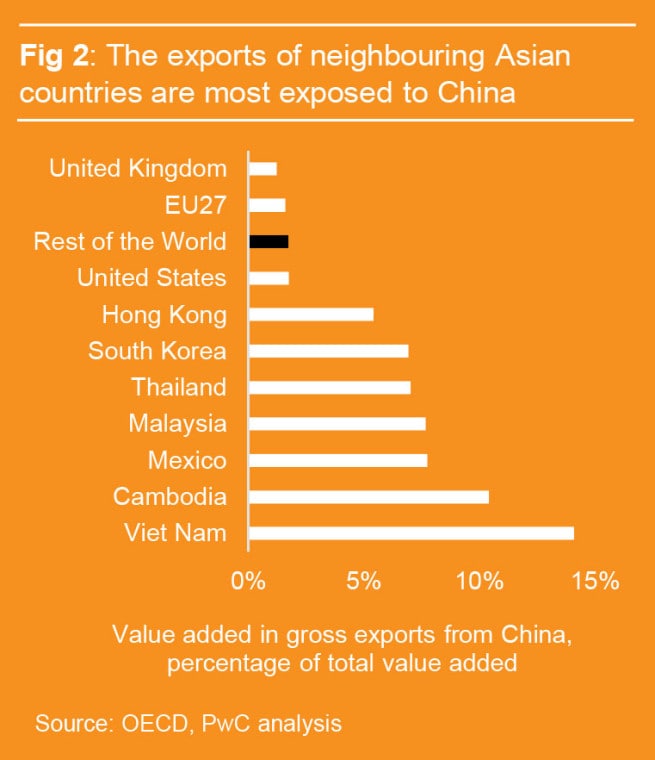
This edition of the Global Economy Watch focuses on an underreported area of the $6 trillion market of export services. Whilst most of the attention of businesses and policymakers has understandably focused on the global trade in goods which has been experiencing tensions, trade in services has been more dynamic as it has been growing at a faster rate than goods trade. Figure 1 shows the market shares of the big services sector which include travel, transport and other business services.
Service exports have traditionally been dominated by large advanced economies. Indeed, in global rankings of services exports, the US, UK and Germany continue to be the undisputed leaders. However, further down the rankings of the world’s largest services exporters, PwC is seeing some of the lagged effects of the shift in global economic power from the West to the East that first started with the manufactured goods sector but is now shifting into the services sector. China, for example, has overtaken Spain, Italy and Japan to become the fifth largest exporter of services in the world.
What does this mean for businesses in the advanced economies? One answer could be to invest in upskilling’ existing and future workers to tackle the challenge of automation in the future. This also makes economic sense as it could also help to lift labour productivity levels that have stagnated in most advanced economies since the 2008 financial crisis. Many large businesses have committed resources to invest in upskilling their staff. However, progress from companies around the world remains slow according to PwC’s latest Global CEO Survey1, as only half of CEOs reported moderate to significant progress in their upskilling programmes.
Lastly, this report takes a preliminary look at some of the impacts the COVID-19 coronavirus is having on businesses and the global economy. We’ve already seen some disruption to the Chinese economy and to the travel and transport services sectors across the world. At the time of writing this report, around 92,000 people globally were infected by the virus, though this is changing from day to day as outbreaks occur outside China. Travel restrictions persist in a growing number of areas across the world. A growing number of businesses are now faced with both supply side constraints and travel restrictions imposed in relation to areas where infections are reported. Events on this issue are unfolding fast and it is too soon to quantify with any confidence the potential societal and business impacts of the virus. We will continue to monitor this risk.


Should we worry about global services trade?
Uncertainty in the global trade arena continues to be a source of concern for many businesses. In our January edition of this report, PwC predicted that globalisation will slow down in 2020 and give way to slowbalisation’. This is particularly relevant for the trading of goods across borders, but should businesses also be concerned about the $6 trillion global services exports market?
Outside of tourism and financial services, trading services across borders is a relatively hard concept to understand. But it is becoming a more important component of the overall global export market in terms of both size and growth rates. Specifically, for every additional dollar exported, 20 cents relate to service exports which, since 2005, are growing faster in real terms compared to the merchandise exports5. This could include any type of service, ranging from a tourist spending money in a foreign country, to an architect designing a building to be constructed abroad.
Global dominance of G7 in services exports gradually being eroded
Historically, advanced economies have been the global champions of service exports. Table 1 shows that the US, UK and Germany occupy the top three spots, accounting for around one quarter of the global market share. But this is gradually changing, as there has been a steady erosion of advanced economies’ share of world service exports since 2005. The G7’s share has steadily fallen from 45% in 2005, to 38% based on the latest data for 2018. Meanwhile, the E7’s6 share has risen from 9% to 12%.
This has seen advanced economies like Japan, the Netherlands, and Spain fall down the league table of global services exporters since 2005, while the larger emerging economies moved up the rankings. Using the latest available data, Table 1 shows that China was the world’s 5 th largest services exporter in 2018, overtaking the Netherlands, Spain and Italy since 2005. China’s exports of services have grown by an average rate of 8% per annum since 2010 in real terms. Meanwhile India has overtaken Japan and held the 8 th spot in the global rankings of service exporters in 2018, up from just 14 th in 2005.
What are the major services exports?
Figure 1 shows that historically the vast majority of services exports have been in three main sectors:
Travel (mainly tourism): Even though this is now one of the slower growing sectors in the G7 and E7, its share of global service exports has remained steadfast at around 25 % over the past fifteen years. Growth in both international visitors and tourism receipts continues to outstrip growth in the global economy, with average annual real growth of around 5% per annum.
Other business services: This sector has the second largest share of global service exports (at 22% in 2018). Both advanced and emerging economies have recorded strong rates of growth at around 5 8% per annum. In both the G7 and E7, technical and trade related services, and professional and management consulting are the most important sub sectors of other business sectors; for the G7, research and development is also key.
Transport: This includes the movement of passengers and freight around the world. Air and sea transport account for roughly equal shares of service exports in this sector at around 40%. The shipping of goods exports is itself a service export, with freight transport accounting for 8% of total global services exports.
Just like the development of the shipping container helped to boost growth in merchandise trade in the last half century, the spread of fixed and mobile broadband internet (and other technologies), along with the lower cost of internet usage, has helped previously small service export sectors grow at rapid rates. For example, the telecommunications and information services sector which includes the broadcast and transmission of data, sound and images, as well as software services, has been the fastest growing services export category globally. In India and China, this sector now accounts for more than 20% of total services exports.
What is the outlook for services trade in the years to come?
PwC analysis suggests the outlook for the trade in global services is mixed, at least in the short run. Our analysis shows that the growth rate of global service exports is highly correlated with growth in merchandise exports. This makes sense as there is a direct link between trading goods across borders and demand for transport services.
There are also spill over effects between goods and services exports. For example, businesses are becoming more creative and are selling goods (e.g. jet engines) embedded with services (e.g. maintenance service contracts for jet engines) as a source of additional revenue without the additional costs associated with finding new clients and markets. As uncertainty in the global merchandise trade sector continues, we expect to see some of this effect spill over into services trade even though the latter is not subject to tariffs.
In the short term, we also expect a slow down in the largest services exports sector, travel, due to COVID-19. China is the world’s largest source of international tourists; in 2018, Chinese tourists made 150 million outbound trips and accounted for around a fifth of global tourism spending. Depending on how long travel restrictions into and out of Chinese Mainland continue, this could have significant consequences for to the international travel and tourism sector.
In the medium to long term however, the outlook for services exports is more positive. In our last World in 2050 report, we projected continued growth in real income levels across both the G7 and E7, which will generate demand for more services. And continued technological breakthroughs, coupled with the spread of faster and cheaper internet connections, mean that newer, more specialised services will continue to be developed, and that it will likely be easier to trade these across borders. On the regulatory front, there are also some tentative steps being made by the WTO to set rules for the digital economy, e commerce and data flows. This could provide an additional impetus to services trade if successfully concluded.
Economic update: Spread of COVID-19 shows how integrated the global economy is
At the time of writing, the COVID-19 outbreak has infected around 92,000 people. Most of the initial economic analysis on the potential impact has focused on the 2003 Severe Acute Respiratory Syndrome (“SARS”) as a case study. This approach, however, misses key changes that have happened since then that mean the economic impact could potentially be significantly larger than the relatively small, temporary impact seen in Q2 2003 due to SARS.
First, during the SARS epidemic, the Chinese economy accounted for less than 10% of global GDP in purchasing power parity (“PPP”) terms, according to the IMF. Today, China accounts for almost 20%, and for about 11% of total global exports ( goods and services).
Second, in the aftermath of China’s entry to the World Trade Organization (“WTO”) in 2001, businesses are increasingly reliant on supply chains that include China.
Figure 2 shows that the South East Asian economies are more reliant on China as a source of input to their exports, compared to the other advanced economies in the West.
A slowing down of the South Eastern economies could have a large impact on global GDP growth. By comparison, the Association of Southeast Asian Nations (ASEAN) countries comprise around 6-7% of global GDP.
COVID-19 is a fast changing risk that should be actively monitored by businesses and policymakers, particularly now there are signs it is spreading more widely outside China. The economic impact will take some time to manifest in the hard economic data, but businesses and wider society have already been feeling the more tangible effects of the virus and the general increase in uncertainty has been felt in asset markets around the world. It represents an important downside risk to the main scenario growth projections in this report, if the crisis deepens significantly.


Tackling the challenge of the future by upskilling the workforce
CEO’s across the world are worried. PwC’s Global CEO Survey shows that more than 8 out of 10 CEOs are concerned about the availability of skills, compared to 5 in 10 in 2012. This trend is driven by three factors. First, relatively low unemployment rates particularly across the Organisation for Economic Cooperation and Development (“OECD”) economies. Without a corresponding increase in participation rates, this means that there is a smaller pool of available workers from which businesses can hire. Second, demographic and societal pressures, as well as indexation mechanisms intended to increase the retirement age in some advanced economies have led to people working longer. Third, higher rates of automation which, according to PwC estimates2, have the potential to displace up to 30% of existing OECD jobs over the next two decades, though PwC analysis also suggests this would be broadly offset by new job creation due to AI, robots and related technologies also boosting economic growth.
Objective: Upskill one billion people by 2030
In view of these challenges, an appropriate response is to upskill the current and future workforce as well as those who are currently excluded from the workforce, to ensure they are better equipped for the future. Upskilling is already creeping up the agenda of global policymakers, businesses and non governmental organisations. For example, this year the World Economic Forum announced its objective to upskill one billion people by 20303, with the backing of numerous governments including the US, France and India.
However, upskilling one billion people out of a global workforce of three and a half billion is not an easy task. Whereas historically businesses would look to governments to drive this type of programme, there is growing awareness of the role business and the wider private sector could play to support upskilling. In fact, PwC’s Global CEO Survey reveals a link between economic optimism, confidence about future revenues and progress in implementing an upskilling programme.
Focus more on those likely to be adversely affected from automation
So which areas should businesses focus their upskilling efforts on? PwC analysis shows that the workers who tend to carry out activities that are more prone to automation are less likely to participate in job related training programmes. For example, Figure 3 shows that those with administrative jobs which are often repetitive and more likely to be automated in the future, are half as likely to receive job related training compared to professionals who are likely to perform less repetitive tasks.
This suggests that there is a pressing need for business leaders to “level up ” the training content in different parts of their organisation. OECD research4 supports this view as they find that the productivity returns from investing in training in low skilled services type jobs is significantly higher compared to those employed in high skilled services.
There is a long way to go
Recently, many large businesses have announced considerable upskilling investments. PwC, for example, intends to invest $3bn over the next four years, primarily to upskill all of its 275,000 employees. But there is a long way to go only half of the CEOs around the world surveyed in PwC’s research reported moderate to significant progress in their upskilling programme.
1. PwC’s 23 rd Global Annual CEO Survey, 2019, accessed via https://www.pwc.com/gx/en/ceo-agenda/ceosurvey.html
2. Will robots really steal our jobs? jobs?, PwC, 2018, accessed via https://www.pwc.co.uk/economic-services/assets/international-impact-of-automation-feb-2018.pdf
3. ‘The Reskilling Revolution’, World Economic Forum, 22 January 2020
4. Returns to different forms of job related training, OECD 2019
5. We used the Balance of Payment definition of services exports. The WTO’s definition of services trade focuses on the nationality rather than the residency of those involved in the trade
6. E7 refers to Brazil. China, India, Indonesia, Mexico, Russia, Turkey

















